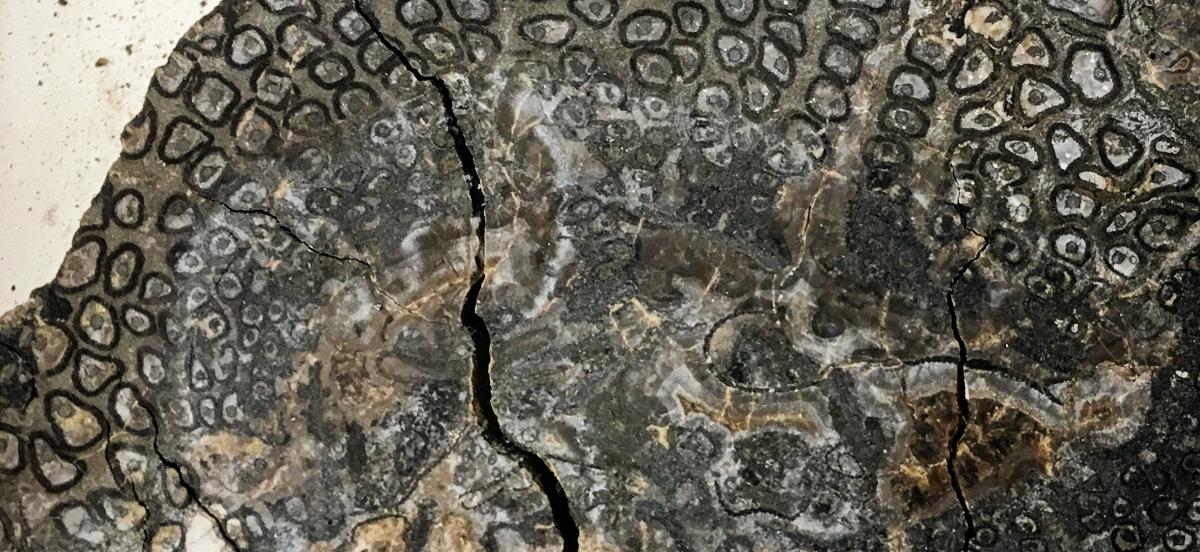Jonathan Wilson Investigates Deep-Time Global Climate Change

Photo of a cross-section of a fossilized tree fern stem (courtesy of the Smithsonian Natural History Museum) from the Carboniferous Period by Jonathan Wilson.
Details
As part of an interdisciplinary, multi-institutional team, the assistant professor of biology published a paper in Nature Geoscience about the implications of the ancient CO2 record for future climate change.
The last time Earth experienced both ice sheets and carbon dioxide levels within the range predicted for this century—roughly 300 million years ago—was a period of major sea level rise, melting ice sheets, and upheaval of tropical forests.
Assistant Professor of Biology Jonathan Wilson is part of an interdisciplinary, multi-institutional, international team of researchers, led by the University of California, Davis, that found that the repeated restructuring of tropical forests at the time played a major role in driving climate cycles between cooler and warmer periods. (The researchers recently published their findings in the latest issue of Nature Geoscience.)
"It's well known that plants and climate show feedbacks today—for example, drought causes plant death and reduces the amount of carbon dioxide stored in plant tissues, thereby increasing atmospheric CO2 concentration and global temperatures," said Wilson. "However, the history of plants' capacity to influence climate is not well understood. In this project, my colleagues and I used a combination of geochemical data and modeling approaches to understand whether and how plants drove climate change more than 300 million years ago."
Using fossilized leaves and soil-formed minerals, the researchers reconstructed the ancient atmospheric carbon dioxide record from 312 to 296 million years ago, when ice last covered Earth’s polar regions and large rainforests expanded throughout the tropics, leaving as their signature the world’s coal resources. These deep-time reconstructions revealed previously unknown fluctuations of atmospheric carbon dioxide at levels projected for the 21st century, highlighting the potential impact the loss of tropical forests can have on climate.
"We show that climate change not only impacts plants but that plants’ responses to climate can in turn impact climate change itself, making for amplified and in many cases unpredictable outcomes," said lead author Isabel Montañez, a Chancellor’s Leadership Professor with UC Davis Department of Earth and Planetary Science. "Most of our estimates for future carbon dioxide levels and climate do not fully take into consideration the various feedbacks involving forests, so current projections likely underestimate the magnitude of carbon dioxide flux to the atmosphere."
Tropical forests 300 million years ago stored massive amounts of carbon dioxide during these ancient glacial periods. The study indicates that repeated shifts in tropical forests in response to climate change were enough to account for the 100 to 300 parts per million changes in carbon dioxide estimated during the climate cycles of the period.
While plant biologists have been studying how different trees and crops respond to increasing carbon dioxide levels, this study is one of the first to show that when plants change the way they function as CO2 rises or falls, it can have major impact, even to the point of extinction.
"For many of these groups of plants, there were threshold climate states that were lethal to some types of plants but not others," said Wilson, "and the relative abundance of different groups of plants with distinct physiological capacities could have had a major influence on regional and global climate."
Over the past million years, atmospheric carbon dioxide has been generally low and fluctuated predictably within a window of 200 to 300 ppm. This, the researchers explain, has sustained the current icehouse—a time marked by continental ice at the polar regions—under which humans have evolved. This trend has been abruptly interrupted by the pronounced rise of carbon dioxide over the past 100 years to the current level of 401 ppm—one not seen on Earth for at least the past 3.5 million years.
The current unprecedented rate of rising atmospheric CO2 raises concerns about melting ice sheets, rising sea level, major climate change, and biodiversity loss—all of which were evident more than 300 million years ago, the only other time in Earth’s history when high CO2 accompanied ice at the polar regions.
In addition to researchers from the University of California, Davis and Haverford College, this study, which was funded by the National Science Foundation and the European Research Council, was co-authored by collaborators at University College Dublin, the University of Michigan, Baylor University, the Smithsonian Museum of Natural History, and the University of Connecticut. Additionally, several of Wilson's current and former Haverford senior thesis students—Remmy Chen '16, Charlie Marquardt '16, Deana Rauh '16, Gabe Oppler '17, and Liz Reikowski, '17—conducted, and are conducting, research that contributed to aspects of this project.
"It is exciting for [my students and I] to contribute to a highly collaborative project to understand ecosystems that once dominated the planet," says Wilson.
-Rebecca Raber and Kat Kerlin of University of California, Davis


